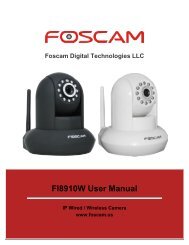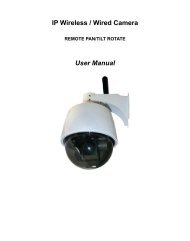CONTENTS - Agasio POE & Wireless IP Cameras
CONTENTS - Agasio POE & Wireless IP Cameras
CONTENTS - Agasio POE & Wireless IP Cameras
You also want an ePaper? Increase the reach of your titles
YUMPU automatically turns print PDFs into web optimized ePapers that Google loves.
1: Outline of how to useFollow the below instructions to get the camera started after it has beenmounted properly. When the <strong>IP</strong> camera is powered on, it will rotate a roundby itself and stop at the center.1) Connect <strong>IP</strong> Camera to LAN (refer to 2.1 for details)2) Install the software of the <strong>IP</strong> Camera (refer to 2.2 for details)3) Start the <strong>IP</strong> Camera “Search Tool” to set the basic configuration. Makesure the subnet mask of the Camera’s <strong>IP</strong> address is the same as LAN’s(refer to 2.3 for details)4) Set the safety property of IE of your PC before viewing it at the first time.(refer to 2.4 for details)5) Camera login (refer to 2.5 for details)6) Setting your <strong>IP</strong> camera (Setting wireless, DDNS, Email, FTP, etc)(refer to 2.6 for details)2: How to setup each step2.1: Connect your <strong>IP</strong> Camera to the network.First Use Network cable connect <strong>IP</strong> Camera to LAN.Figure 2.11
2.2: Install the following software before view video.(1): Install OCX SetupFigure 2.2Insert the attached CD-ROM into the CD-ROM driver, find the belowicon , double click it and this window will pop- up, click “OK”, then this ActiveX is successfully installed.(2): Install Search tool software.After OCX setup is finished, find the following icon in your CD-ROM,copy it and paste it on the desktop of your computer, ( Note:when you need use the Search tool to find the <strong>IP</strong> address of the <strong>IP</strong> camera,you can directly use it no need to find the CD)2.3: Basic configuration setting.After you finished installation of OCX and Copy the Search Toolsoftware, you will find the icon on your computer desktop .Double click it, and then pops up the following interface:2
Figure 2.3If network cable and power supply are correctly connected, device type, name and<strong>IP</strong> address will be shown in the Equipments list (Otherwise, please confirm whetherpower supply and network cable work normally).In the interface above, the configuration information of the current computer islisted on the left side; and the network configuration information of the selected device islisted on the right side. Default <strong>IP</strong> address of the <strong>IP</strong> camera is 192.168.1.99, and HTTPport is 99.Note: The <strong>IP</strong> address and the HTTP Port of the <strong>IP</strong> camera can be changed to as your wanted..Inner Access refers to the LAN access address; Outer Access refers the WAN accessaddress.Tips: Port forwarding setting is necessary for outer access, pleaserefer to ‘Port forwarding Settings ’in 4.1 section.3
Note1. Device information indicates the <strong>IP</strong> camera information.2.When thecurrent computer has a fixed <strong>IP</strong>, (namely non-DHCP <strong>IP</strong>), and the <strong>IP</strong>camera is used for the first time, please click Update, so that <strong>IP</strong> addressof the <strong>IP</strong> camera, gateway and DNS can be synchronous with the PC.3.If it is necessary to manually modify the contents including cameraname, HTTP port, <strong>IP</strong> address, sub mask, gateway, primary DNSserver, secondary DNS server and so on, please click apply aftermodification, and then click OK after entering username and passwordof the <strong>IP</strong> camera in the pop-up dialog box for access validation.2.4: Camera LoginOpen it directly by first clicking the Inner Access or Outer Access on Finder and then clickingOpen; and you can also directly input the corresponding address of the inner and outer accessinto the address bar of the web page, as the address shown in the picture abovehttp://192.168.1.99:99 (LAN); and http://demo.88safe.com:99 (WAN)Figure 2.44
4) <strong>IP</strong> camera control interface.Figure 2.5Figure 2.65
2.5 “No Image” Problem SolvingThe video streaming is transmitted by the ActiveX controller. If ActiveXcontroller isn’t installed correctly you will see no video image. There aretwo ways to resolve this problem:1Install “<strong>IP</strong> Camera Tool”, ActiveX controller is installed simultaneouslyrecommendable.2Download ActiveX controller and set the safety property of IE of yourPC before you view it for the first time:“IE” browser “Tool”“Internet Proper”“Security”“CustomLevel””ActiveX control and Plug-ins” three options of front should be setto be “Enable”, The ActiveX programs read by the computer will be stored.as follows:Enable: Download unsigned ActiveX controlsEnable: Initialize and script ActiveX controls not marked as safeEnable: Run ActiveX controls and plug-insFigure 2.72.6: Setting wireless, DDNS, Email, FTP, Mutil_device2.6.1 Setting Wi-Fi of <strong>IP</strong> CameraThere are two way to setup the wireless network, One by the Softwareautomatically setting, one by manually setting. Here we only introduce thefirst one.6
Software Automatically Setting:First you need make sure that your wireless network is working well.1): Click “Scan”, the wireless network will be listed on the wirelessNetwork List. Here you need click “Scan” twice. Then the around wirelessnetwork will automatically appear in the “<strong>Wireless</strong> Network List”.2): Double-click the <strong>Wireless</strong> Network you want to use. Then the choosedwireless network information (SSID, Network Type, Encryption) will besigned automatically.3): Sign in the password of the wireless network . Finally click “Submit”.1:2:After click Submit the camera will reboot the device.NOTE: The product supports WEP and WAP security encryption.(As follows)4) Wait at least 30 seconds to unplug the Ethernet cable, and then unplug thepower supply.5) Plug the power supply making sure that the Ethernet is not connected6) After around 30 seconds, if the LED blinks, it indicates it is working inwifi mode7) Camera login.7
2.6.2 How to use DDNSWhen use ADSL, the <strong>IP</strong> Camera will connect to the Internet through ADSLautomatically. For each ADSL reconnection, ISP will re-assign a new <strong>IP</strong>address for the <strong>IP</strong> Camera to facilitate the access. DDNS (Dynamic DomainName Server) can map the dynamic <strong>IP</strong> address of an <strong>IP</strong> Camera to a fixeddomain name. Therefore, we can access to the <strong>IP</strong> Camera by the fixeddomain name whether the <strong>IP</strong> address changes or not. The <strong>IP</strong> address is notnecessary when you using the DDNS via the domain name to find yournetwork.1) Go to the website which Provides free domain name, register and apply afree domain name. Such as http://www.dyndns.com/(details:3.2 ).2) Login the Camera homepage as Administration and enter “DDNS ServiceSettings” page input the name, password and Host (details: 3.1) .Then click and reboot Device.3) Re-login the Camera homepage and enter “Device Status” page tocheck whether the DDNS Status is DynDns Succeed or not.4) Enter “UPnP Settings” page, the UPnP Status should be UPnP Succeed.If the status is not Succeed, you may enter “Basic Network Settings” pageto change Http Port . Then click and reboot Device.5) Re-login the Camera homepage to check and make sure the DDNS Statusand UPnP Status is Suceed.6) You only need to enter the domain name (domain name + Port numberhttp://ipcame.kicksafe.net:99/) in the IE address bar, the browser will visitthe <strong>IP</strong> Camera.Wait for several minutes and the <strong>IP</strong> Camera will dial up to access theInternet automatically, and the communication with the DDNS server isestablished successfully. In the way, the user can access the <strong>IP</strong> Camera froma WAN by using the DDNS domain name.If the gateway settings and DDNS settings have been completed, enter theDDNS dynamic domain name (for example, http://ipcasafe.vicp.net/,do notadd www.) in the address bar of the IE to access the <strong>IP</strong> Camera. If multiple8
<strong>IP</strong> <strong>Cameras</strong> are connected to the same router, enter DDNS dynamic domain+ port number (for example, http://ipcamerasales.dyndns.org:99/)in theaddress bar of the IE to access different <strong>IP</strong> <strong>Cameras</strong>.2.6.3 Multi-Device Settings(1): Add cameras in LANIn the Multi-Device Settings page, you can see all devices searched in LAN.The 1st Device is this device default. You can add more cameras list in LANfor monitoring. This Web software supports up to 9 <strong>IP</strong> <strong>Cameras</strong> onlinesimultaneously. Click “The 2ND Device” and Double click the item in theDevice List in Lan”, Alias, host and Http Port will fill in automatically.Enter the correct username and password then click “add”. Add morecameras in the same way.(2)Add cameras in the InternetFigure 2.10Firstly, make sure the camera added can access in the Internet with the <strong>IP</strong>address or DDNS domain. like this:http://202.96.133.114: 9008 orhttp://<strong>IP</strong>cameras.dyndns.org:9008 You can enter the Host: 202.96.133.134port: 9008 or Host: <strong>IP</strong>camera.dyndns.org port: 9008.Enter the correctusername and password then click “add”. Add more cameras in the sameway as shown in Figure 2.129
Figure 2.11Figure 2.122.6.4 Email and FTP Settings10
Before setting Mail and FTP Service. Make sure NNDS Service is succeed,and the <strong>IP</strong> Camera’s DNS Server the same as the romter’sFigure 2.13Figure 2.14Note: When Alarm Service Settings Send Mail on Alarm is check, theMail Service takes effect.Configure the E-mail box to receive and send mails. The E-mail box is usedfor receiving the images sent after alarm and the system <strong>IP</strong> address aftersuccessful dial-up.Sender: This device uses the sender mailbox to send mails.Receiver: To receive the mail from the Sender. You can set up to 4 receivermailbox.SMTP Server: the SMTP server for the sender mailboxNeed Authentication: if the sender mailbox need authentication, you shouldcheck it then input the SMTP username & Password.Mail test: Please set the Mail parameter and click "Submit" first. There areMail test result.1 Can not connect to the server2 Network Error. Please try later3 Server Error4 Incorrect user or password11
5 The sender is denied by the server. Maybe the server need to authenticatethe user, please check it and try again6 The receiver is denied by the server. Maybe because of the anti-spamprivacy of the server7 The message is denied by the server. Maybe because of the anti-spamprivacy of the server8 The server does not support the authentication mode used by the deviceReport Internet <strong>IP</strong> by Mail: When ip cam power on or Internet <strong>IP</strong> changed,it will send the internet <strong>IP</strong> by mail.(for example: <strong>IP</strong>CAM 's url ishttp://119.123.208.96:9002). Make sure the port is map to the routercorrectly by UPNP or Virtual Map function.Settings the FTP Service.Figure 2.15Note: When Alarm Service Settings> Upload Image on Alarm ischeck, the FTP Service takes effect.FTP Server: the FTP server address.FTP port: the port usually is 21FTP Mode: support standard(POST) mode and passive(PASV) mode.Upload Image Now: it will upload image now when checkbox is notchecked. When checked, you can input upload interval(Seconds) .FTP test: set the FTP parameter and click "Submit" first. Then click“FTP test” if succeed, it will display the prompt “FTP test succeed”.There is FTP test result:1 Can not connect to the server. Please check FTP Server is corrector not.2 Network Error, Please try later.3 Server Error.12
4 Incorrect user or password. Please check the username andpassword is correct or not.5 Can not access the folder. Please be sure the folder exists and youraccount is authorized6 Error in PASV mode. Please be sure the server support PASVmode7 Error in PORT mode. PASV mode should be selected if the deviceis behind a NAT8 Can not upload file. Please be sure your account is authorizedFigure 2.163. DDNS Guide3.1 DDNS Service SettingsDDNS Service: The system supports protocols from some DDNS providers:Dyndns.org.User and Password: the user name and password used when applying forthe domain name. (details: 2.6.2-1)DDNS Host: the Domain NameFor example: Your registered Dyndns as below:User name : kevinzhu Password : ddynsDDNS Host ( Dynamic DNS Host Name) : kevinsafe.dyndns.org1): Input the DDNS information as Figure 3.1:13
Figure 3.12): Click “submit” ….. The device will rebooted automatic. Afterrebooted you will back to the “Device Info” interface. Then you will seethe DDNS Status is succeed.( Figure 3.2)3): If you find the DDNS Status is not succeed please make sure youhave done the “Port Forward” successfully.4): If you are sure that the “Port Forward” is succeed but the DDNSStatus is not succeed. Please click “ ” .Figure 3.25): Input Dynamic Domain Name: http://kevinsafe.dyndns.org:99 in yourbrowser.14
Figure 3.33.2: Procedures of DDNS registerStep1: enter http://www.dyndns.com/ and Create AccountFigure 3.2Step2: enter your information15
Figure 3.3Step3: After a minute, you will receive a E-mail from DynDNS Support andit will give you a confirmation address(e.g. https://www.dyndns.com/confirm/create/ONMzltcCBk6mcHJI5MhVD0g)Figure 3.416
Figure 3.5Step4: When the Account Confirmed, login and start using your account.Choose Add Host Services(Figure 3.6) and enter Add New Hostname(Figure 3.7)page.Figure 3.617
Figure 3.7Step5: On the Add New Hostname page.1) input your Hostname.2) choose Host with <strong>IP</strong> address3) click Use auto detected <strong>IP</strong> address xxx.xx.xx.xxx. Then click Create Host.4) after you have added a New Hostname , you need “Proceed to checkout”Figure 3.818
Figure 3.9Figure 3.10Step6: Now you obtained a Dynamic Domain Name(Figure3.10),and can useit in the DDNS Service Settings(details: 3.1)Notice:If you have a dynamic <strong>IP</strong> address, Make sure you have download theDynDNS’s “Update Client”. And installed it succeed in your computer.19








